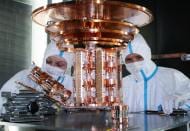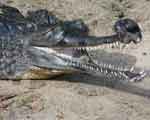Science News quotes SMU physicist Dr. Jodi Cooley in its Sept. 12 report “Hints of dark matter reported, again.”
The online story notes that two of the world’s particle detectors differ on whether dark matter has been spotted. Science journalist Devin Powell asked Cooley, assistant professor of experimental particle physics in SMU’s Physics Department, to weigh in on the matter.
Cooley is part of the international collaboration of scientists that is hunting for dark matter on the CDMS II experiment in Minnesota’s Soudan mine.
EXCERPT:
By Devin Powell
Science News
In the war of the WIMPs, a new combatant has joined the fray. The CRESST-II experiment has seen hints of the weakly interacting massive particles, a leading candidate for the hidden dark matter thought to account for most of the universe’s matter.The new results, reported September 6 at the International Conference on Topics in Astroparticle and Underground Physics in Munich, add controversy to an already contentious field that is divided into two camps: those that have seen signs of the particles and those that haven’t.
“It’s another small victory for those arguing that this is dark matter, but it’s not going to decisively determine anything,” says theorist Dan Hooper of the University of Chicago and the Fermi National Accelerator Laboratory in Batavia, Ill. “We still haven’t seen a smoking gun.”
…
To further complicate the picture, though, these two experiments must be reconciled with results from the DAMA/LIBRA experiment. Its sodium iodide detector in Gran Sasso has found evidence for WIMPs that suggests slightly different properties for the particles than what’s been hinted at in the more recent work.
“I don’t think we know for sure exactly what is going on,” says Jodi Cooley, a particle physicist at Southern Methodist University in Dallas. “Based on the understanding we have of dark matter and how it behaves, I’m not sure how much agreement I would say that these experiments have.”
Cooley works on the CDMS II experiment in Minnesota’s Soudan mine, one of two detectors that have seen no signs of dark matter or its purported particles at all. XENON100, which searches for dark matter using a tank of noble gas in Gran Sasso, has ruled out all of the WIMPs proposed by CRESST-II and its compatriots.
Cooley also was quoted in a story by Physicsworld.com, “CRESST uncovers hint of dark matter,” published online Sept. 8.
EXCERPT:
… The question is whether the signal from CRESST, which points to a relatively light WIMP, can be reconciled with results from other direct-detection experiments. DAMA and CoGeNT have both recorded positive signals, but not for WIMPs with the same range of properties. Worse, the CRESST signal suggests a WIMP with properties that had previously been ruled-out by experiments such as XENON and CDMS, the latter of which is based at the Soudan mine.
“It is clear that it is difficult to reconcile the results from CDMS, XENON, CRESST and other dark-matter experiments with a single, simple dark-matter interpretation,” says Jodi Cooley, a physicist at the Southern Methodist University in Texas, US, who works on the CDMS experiment. “So, that leaves one of two possibilities. Either dark matter is behaving in a very strange way that we do not understand, or the backgrounds in the CRESST experiment are not well enough understood. To me, these results underline the need to have experiments that are capable of operating a mode where background subtraction is not necessary.”
Not everyone agrees. The properties of a detected WIMP are estimates, liable to change with varying assumptions about the equipment used. This leads some physicists to believe that the positive results can be reconciled.
 Science News quotes SMU physicist Dr.
Science News quotes SMU physicist Dr. 






